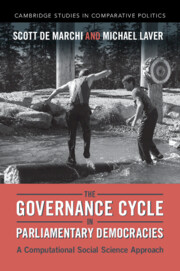Refine search
Actions for selected content:
20 results
Political knowledge and perceptions of minority governments in Europe
-
- Journal:
- European Journal of Political Research ,
- Published online by Cambridge University Press:
- 15 October 2025, pp. 1-13
-
- Article
-
- You have access
- Open access
- HTML
- Export citation
Bargaining Complexity Beyond Arithmetic
-
- Journal:
- British Journal of Political Science / Volume 55 / 2025
- Published online by Cambridge University Press:
- 27 August 2025, e114
-
- Article
-
- You have access
- Open access
- HTML
- Export citation
Government formation in presidentialism: Disentangling the combined effects of pre-electoral coalitions and legislative polarization
-
- Journal:
- Latin American Politics and Society / Volume 67 / Issue 1 / February 2025
- Published online by Cambridge University Press:
- 23 September 2024, pp. 36-55
-
- Article
- Export citation
Normal Mode Copulas for Nonmonotonic Dependence
-
- Journal:
- Political Analysis / Volume 32 / Issue 4 / October 2024
- Published online by Cambridge University Press:
- 13 February 2024, pp. 417-430
-
- Article
-
- You have access
- Open access
- HTML
- Export citation
3 - The Entry of Populist Radical Right Parties into Local Power
-
- Book:
- Restrained Radicals
- Published online:
- 10 August 2023
- Print publication:
- 10 August 2023, pp 60-100
-
- Chapter
- Export citation
Now You See Me, Now You Don't: Anticipatory Coalitional Strategies in European Representative Democracies
-
- Journal:
- Government and Opposition / Volume 59 / Issue 2 / April 2024
- Published online by Cambridge University Press:
- 10 February 2023, pp. 504-525
-
- Article
-
- You have access
- Open access
- HTML
- Export citation
Introduction
-
- Book:
- The Governance Cycle in Parliamentary Democracies
- Published online:
- 02 February 2023
- Print publication:
- 09 February 2023, pp 1-8
-
- Chapter
- Export citation
2 - The Governance Cycle
-
- Book:
- The Governance Cycle in Parliamentary Democracies
- Published online:
- 02 February 2023
- Print publication:
- 09 February 2023, pp 36-59
-
- Chapter
- Export citation
1 - Governance, Complexity, Computation, and Rationality
-
- Book:
- The Governance Cycle in Parliamentary Democracies
- Published online:
- 02 February 2023
- Print publication:
- 09 February 2023, pp 9-35
-
- Chapter
- Export citation

The Governance Cycle in Parliamentary Democracies
- A Computational Social Science Approach
-
- Published online:
- 02 February 2023
- Print publication:
- 09 February 2023
Government Formation and the Radical Right: A Swedish Exception?
-
- Journal:
- Government and Opposition / Volume 58 / Issue 4 / October 2023
- Published online by Cambridge University Press:
- 02 March 2022, pp. 882-898
-
- Article
-
- You have access
- Open access
- HTML
- Export citation
Cabinet Composition, Collegiality, and Collectivity: Examining Patterns in Cabinet Committee Structure
-
- Journal:
- European Political Science Review / Volume 14 / Issue 1 / February 2022
- Published online by Cambridge University Press:
- 17 December 2021, pp. 115-133
-
- Article
- Export citation
Faraway, so close: a spatial account of the Conte I government formation in Italy, 2018
-
- Journal:
- Italian Political Science Review / Rivista Italiana di Scienza Politica / Volume 52 / Issue 1 / March 2022
- Published online by Cambridge University Press:
- 26 April 2021, pp. 83-100
- Print publication:
- March 2022
-
- Article
-
- You have access
- Open access
- HTML
- Export citation
Losers together? Grand coalitions in the EU member states
-
- Journal:
- Italian Political Science Review / Rivista Italiana di Scienza Politica / Volume 51 / Issue 3 / November 2021
- Published online by Cambridge University Press:
- 12 April 2021, pp. 404-418
- Print publication:
- November 2021
-
- Article
-
- You have access
- Open access
- HTML
- Export citation
A General Approach to Measuring Electoral Competitiveness for Parties and Governments
-
- Journal:
- Political Analysis / Volume 29 / Issue 3 / July 2021
- Published online by Cambridge University Press:
- 11 November 2020, pp. 337-355
-
- Article
-
- You have access
- Open access
- HTML
- Export citation
Bicameralism and government formation: does bicameral incongruence affect bargaining delays?
-
- Journal:
- European Political Science Review / Volume 12 / Issue 4 / November 2020
- Published online by Cambridge University Press:
- 08 July 2020, pp. 469-484
-
- Article
- Export citation
Coalition Bargaining Duration in Multiparty Democracies
-
- Journal:
- British Journal of Political Science / Volume 50 / Issue 1 / January 2020
- Published online by Cambridge University Press:
- 22 December 2017, pp. 261-280
-
- Article
- Export citation
New parties, information uncertainty, and government formation: evidence from Central and Eastern Europe
-
- Journal:
- European Political Science Review / Volume 8 / Issue 3 / August 2016
- Published online by Cambridge University Press:
- 10 April 2015, pp. 449-472
-
- Article
- Export citation
Presidential Elements in Government Poland – semi-presidentialism or ‘rationalised parliamentarianism’?
-
- Journal:
- European Constitutional Law Review / Volume 2 / Issue 2 / June 2006
- Published online by Cambridge University Press:
- 14 July 2006, pp. 253-267
-
- Article
-
- You have access
- Export citation
Presidential Elements in Government Experimenting with Constitutional Change: Direct Election of the Prime Minister in Israel
-
- Journal:
- European Constitutional Law Review / Volume 2 / Issue 1 / February 2006
- Published online by Cambridge University Press:
- 20 March 2006, pp. 60-80
-
- Article
-
- You have access
- Export citation
